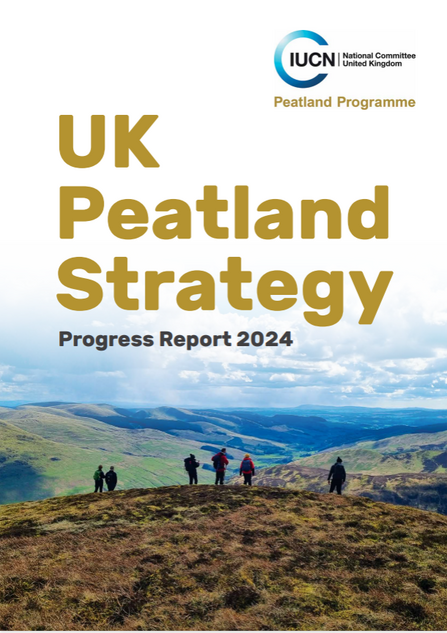The IUCN UK Peatland Programme (IUCN UK PP) publishes a new report today which reveals for the first time that 250,000 hectares (ha) of restoration has been undertaken across the UK’s peatlands since the process began 30 years ago. While this is an impressive achievement to be celebrated, it is a long way short of what is needed to meet the UK’s nature and climate commitments.
View the report here.
The scale of damage to the UK’s 3 million hectares of peatlands is vast. The IUCN UK PP’s peatland strategy highlighted that an estimated 80% of UK peatlands have been damaged by drainage, agricultural intensification and unsustainable practices. The current IUCN target to restore 2 million ha by 2040 would mean that two-thirds of UK peatlands could help nature recover and store carbon. However, current estimates show that this target is unlikely to be met.
The UK is known for its impressive areas of blanket bog – one type of peatland – including the recently designated UNESCO Flow Country World Heritage Site. It also has a vast network of raised bogs and fens across the UK. These habitats are vital for rare wildlife and to provide drinking water as well as climate and flood mitigation; they are also deeply entwined in the UK’s cultural identity.
Early adopters of peatland restoration have been working hard to repair damaged peatlands since the 1990s. So far, the IUCN UK PP reports that charities, partnerships land managers and government agencies have succeeded in restoring 250,000 ha – this is the equivalent to a 1 metre wide peaty-carpet wrapped around the world 60 times.
However, despite these impressive levels of restoration, this represents action on only around 10% of damaged peatlands and the IUCN UK PP calls for greater levels of funding, co-ordination and efficiency to meet the challenge set out in the UK Peatland Strategy. These findings are discussed in detail in their new report which examines the progress against domestic and international targets.
Director of the IUCN UK Peatland Programme, Dr Emma Hinchliffe, said:
“While it’s great to be able to appreciate the impressive peatland restoration efforts for the first time – and the extraordinary achievement of so many charities and individuals that have made this possible – we need to ramp up the pace of recovery now and Governments must take more responsibility for monitoring peatland recovery. For example, many restored peatlands may need additional investment to ensure they recover to health. And for the remaining c. 1.7 million ha of degraded peatlands, we need to ensure that their condition is monitored to be able to guide future restoration, management or land use activities.”
Rob Stoneman, Vice-Chair of the IUCN UK Peatland Programme and Director of Landscape Recovery at The Wildlife Trusts, said:
“Peatlands are magical places. When they’re in good health these water-logged habitats are home to an astonishing range of wildlife – from scarlet sphagnum mosses to golden plover and lime-green lizards – and the layers of wet soils have an extraordinary ability to lock-in carbon, helping to mitigate climate change. Nature charities are leading a large proportion of restoration projects to date, particularly in England where The Wildlife Trusts and others are restoring peatland on a huge scale. We are hopeful that with a new government there is opportunity for a further step-change and increased funding and policy support to bring our peatlands back to health.”
The UK Peatland Strategy Progress Report is being launched at the largest gathering of peatland experts in the UK to date. Over 400 people are attending the IUCN UK Peatland Programme conference in Aviemore from 17th – 19th September 2024. At the event, the UK’s progress will be debated and experts gather to showcase the innovation and inspiring action which is ongoing to recover the UK’s peatland.
Northern Ireland’s DAERA Minister Andrew Muir said:
“Our peatlands are of enormous importance to our environment, affecting our water quality, conserving biodiversity and in mitigating climate change by storing carbon. DAERA is continuing to support the restoration of peatlands in Northern Ireland including through the Environment Fund and the recently announced £3m Shared Island Peatland Challenge Fund. This funding enables our partners to take forward peatland restoration projects as well as engaging with landowners, building capacity and creating jobs. It will also help us to restore our environment to a condition that is healthy and meet our biodiversity targets and our Net Zero contribution.”
Scottish Agriculture Minister Jim Fairlie said:
“Scotland is fortunate enough to have 13% of the world’s blanket bog so it is critically important we mitigate and adapt to tackle the linked climate and nature emergencies, with last year our most successful year of restoration to date through the Peatland ACTION partnership, IUCN UK Peatland Programme, and other levers to increase the scale of the work achieved.
“I am delighted to be attending this year’s conference where we have the chance to meet with international partners to look at how we all drive this work forward and continue to make progress in bringing down our net emissions.”
Natural Resources Wales’ Senior Specialist Advisor on Peat, Dr Peter Jones MBE, said:

